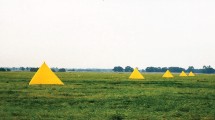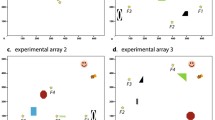Abstract
Here we investigate the counting ability in honeybees by training them to receive a food reward after they have passed a specific number of landmarks. The distance to the food reward is varied frequently and randomly, whilst keeping the number of intervening landmarks constant. Thus, the bees cannot identify the food reward in terms of its distance from the hive. We find that bees can count up to four objects, when they are encountered sequentially during flight. Furthermore, bees trained in this way are able count novel objects, which they have never previously encountered, thus demonstrating that they are capable of object-independent counting. A further experiment reveals that the counting ability that the bees display in our experiments is primarily sequential in nature. It appears that bees can navigate to food sources by maintaining a running count of prominent landmarks that are passed en route, provided this number does not exceed four.





Similar content being viewed by others
References
Agrillo C, Dadda M, Bisazza A (2007) Quantity discrimination in female mosquitofish. Anim Cogn 10:63–70
Chittka L, Geiger K (1995) Can honeybees count landmarks? Anim Behav 49:159–164
Chittka L, Kunze J, Geiger K (1995) The influence of landmarks on distance estimation of honeybees. Anim Behav 50:23–31
Davis H, Pérusse R (1988) Numerical competence in animals: definitional issues, current evidence, and a new research agenda. Behav Brain Sci 11:561–615
Dehaene S (1999) The number sense: how the mind creates mathematics. Oxford University Press, Oxford
Hauser M (2000) Wild minds: what animals really think. Allen Lane, London
Esch H, Burns JE (1996) Distance estimation by foraging honeybees. J Exp Biol 199:155–162
Franks NR, Dornhaus A, Metherell BG, Nelson TR, Lanfear SAJ, Synes WS (2006) Not everything that counts can be counted: ants use multiple metrics for a single nest trait. Proc R Soc B 273:165–169
Gallistel CR (1990) The organization of learning. MIT Press, Cambridge, pp 317–350
Gallistel CR, Gelman R (2000) Non-verbal numerical cognition: from the reals to integers. Trends Cogn Sci 7:307–314
Karban R, Black CA, Weinbaum SA (2000) How 17-year cicadas keep track of time. Ecol Lett 3:253–256
Killian A, Yaman S, Von Fersen L, Güntürkün O (2003) A bottlenose dolphin discriminates visual stimuli differing in numerosity. Learn Behav 31:133–142
Pepperberg IM (2006) Grey parrot numerical competence: a review. Anim Cogn 9:377–391
Roberts WA, Roberts S, Kit AB (2002) Pigeons presented with sequences of of light flashes use behavior to count but not to time. J Exp Psychol Anim Behav Proc 28:137–150
Rugani R, Regolin L, Vallortigara G (2007) Rudimental numerical competence in 5-day-old domestic chicks (Gallus gallus): identification of ordinal position. J Exp Psychol 33:21–31
Si A, Srinivasan MV, Zhang SW (2003) honeybee navigation: properties of the visually driven ‘odometer’. J Exp Biol 206:1265–1273
Srinivasan MV, Lehrer M (1988) Spatial acuity of honeybee vision and its spectral properties. J Comp Physiol A 162:159–172
Srinivasan MV, Zhang SW, Altwein M, Tautz J (2000) Honeybee navigation: nature and calibration of the ‘odometer’. Science 287:851–853
Srinivasan MV, Zhang SW, Bidwell NJ (1997) Visually mediated odometry in honeybees. J Exp Biol 200:2513–2522
Uller C, Jaeger R, Guidry G, Martin C (2003) Salamanders (Plethodon cinerus) go for more: rudiments of number in an amphibian. Anim Cogn 6:105–112
Vladusich T, Hemmi J, Srinivasan MV, Zeil J (2005) Interactions of visual odometry and landmark guidance during food search in honeybees. J Exp Biol 208:4123–4135
West RE, Young RJ (2002) Do domestic dogs show any evidence of being able to count? Anim Cogn 5:183–186
Wiese H (2003) Numbers, language and the human mind. Cambridge University Press, Cambridge
Zar JH (1999) Biostatistical analysis. Prentice Hall, Upper Saddle River
Acknowledgments
We thank Hong Zhu for assistance. Financial support was provided by the Royal Physiographic Society, the Swedish Research council (623-2004-2903) and the ARC Centre of Excellence in Vision Science (CE0561903).




